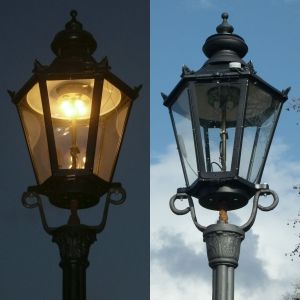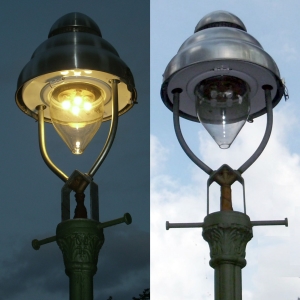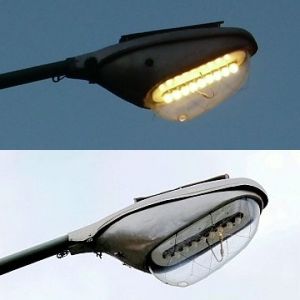
deutsch
The Five Basic Types of Berlin's Gas Street-lighting

Traditional Berlin gas lamp by night and by day
©Gaslicht-Kultur e.V.
1. Traditional Berlin Gas Lamps
Quantity: 900
In use since: 1892
Number of mantles: 4
Mast form: clustered pier mast
Mostly to be found in: Charlottenburg, Spandau
Worth seeing: Chamissoplatz, Kreuzberg
Facts:
The standard model of the Berlin Municipal Gasworks of 1892/93 was the traditional Berlin gas lamp, better known as the Schinkel-lamp. The design of this lamp was a further development of earlier designs by Karl Friedrich Schinkel.
The original design of this model was equipped with two gas mantles. From the 1950s onward, some of these lamps were converted to the version with four mantles in widespread use today. In the course of the modifications, however, most of them were replaced by pole-top lamps of the BAMAG U7 type, which are introduced below. Most of these lamps are mounted on ornate masts known as clustered pier masts. In some places in Berlin, such as the historical parts of Spandau, this form is mounted on wall brackets. An alternative form is the candelabra with two, three or five lamps on it. There is an original five-lamp candelabra from 1903 in Schloßstraße in Charlottenburg. Today, you can find faithful reproductions of this candelabra in Wilmersdorfer Straße, on Stuttgarter Platz, on Karl-August-Platz and in the open-air gaslight museum. There are other five-lamp models at Hohenzollernplatz in Nikolassee and in front of the subway station Dahlem-Dorf. Two- and three-lamp versions of this candelabra can be found in Alt-Tegel and other places in Berlin.
Berlin still has about 900 examples of traditional lamps on clustered pier masts like the ones shown here, mainly to be found in the vicinity of Charlottenburg Palace, around Chamissoplatz in Kreuzberg and, often on wall brackets, in the historic center of Spandau. They can be found as well in selected streets and squares and in the village greens of Hermsdorf, Lübars, Tegel, Kaulsdorf, Marienfelde and Lichtenrade.
 Pole-top lamp by night and by day ©Gaslicht-Kultur e.V.
Pole-top lamp by night and by day ©Gaslicht-Kultur e.V.2. Pole-top Lamps
Quantity: 22,000 (in 2021)
In use since: 1920s
Number of mantles: 4
Mast form: clustered pier and steel masts
Mostly to be found in: downtown districts
Worth seeing: Leonhardtstraße, Charlottenburg
Facts:
This is the best-known type of gas lamp in Berlin, in use since the 1920s. In its present form, with the name BAMAG U7, it was used since the 1950s to replace traditional lamps or older pole-top lamps and to reduce the distances between existing gas streetlights. There are about 22,000 examples of this most common Berlin gas streetlight.
From the beginning, these lamps usually had four mantles, but there were a few rare specimens with six. Like the traditional lamps, the heads of these lamps are mounted on clustered pier masts, with some mounted on normal steel masts of various designs. Some of the clustered pier masts bear the letters I.C.G.A. This is the abbreviation for the former mast manufacturer "Intercontinental Gas Association" and means that these masts are over 100 years old. Cast-iron, compound pillar masts, owing to the durability of the material, last almost indefinitely and the smooth, steel masts, through which gas flows, cannot rust from the inside. They, too, remain in excellent technical condition even after many years of use.
Pole-top lamps still illuminate large residential neighborhoods, from the northern through the southern parts of western Berlin and are almost exclusively to be found in residential streets. Leonhardtstraße in Charlottenburg is a special case: there, the lamps are in double rows on either side of the street, one row towards the street and the other along the sidewalk - four rows in all.
 Suspended lamp by night and by day ©Gaslicht-Kultur e.V.
Suspended lamp by night and by day ©Gaslicht-Kultur e.V.3. Suspended Lamps
Quantity: 1.900
In use since: 1906
Number of mantles: 4,6 or 9
Mast form: pointed arch, gallows, bishop's crook
Mostly to be found in: Kreuzberg, Schöneberg
Worth seeing: Schloßstraße, Charlottenburg
Facts:
Suspended lamps were installed in Berlin since the early 20th century. They were most widespread during the thirty-year period from 1920 to 1950. Because their light point is high above the pavement, these lamps are especially suitable for busy thoroughfares. The BAMAG A11 type, which, along with the A21, is in use today, has been deployed since the 1940s.
Most suspended lamps have four or nine gas mantles and are mounted on different types of masts, some of which are richly decorated. These masts often stem from the era of the preceding models. Some notable mast forms are the so-called Großer Galgen (large gallows) and Großer Bischofsstab (large bishop's staff).
Starting in the 1950s, suspended lamps in thoroughfares were replaced by more modern in-line lamps. About 1,900 suspended lamps still exist in Berlin today, most of them in Kreuzberg. Two pilot projects can be found in Sophie-Charlotten-Straße (Charlottenburg) and in Reichenberger Straße (Kreuzberg): here, suspended lamps illuminate the street and traditional or pole-top lamps light the sidewalks. These projects were realized in cooperation with Gaslicht-Kultur (formerly Gaslichtinitiative Berlin) and averted the conversion of these two streets to electric lighting.
 In-line lamp by night and by day ©Gaslicht-Kultur e.V.
In-line lamp by night and by day ©Gaslicht-Kultur e.V.4. In-line Lamps
Quantity: 260
In use since: 1951
Number of mantles: 4 or 6, formerly also 9
Mast form: whip-shaped or cantilever
Mostly to be found in: Charlottenburg, Wilmersdorf
Worth seeing: Rüdesheimer Platz, Wilmersdorf
Facts:
They were the last new development in gas streetlighting and in the 1950s and '60s often replaced suspended lamps on thoroughfares and broad side streets. Most newly built streets were also equipped with them. The type which is prevalent today, BAMAG U13H, existed in three sizes, with four, six or nine mantles. (Those with nine mantles have meanwhile been replaced.) The heads of this model are found on different mast forms, most typically "whip masts", but also on extension arm masts, which in turn were made from the masts of former suspended lamps.
The in-line lamp is an original Berlin development. It was developed in the early 1950s by engineer Wilhem Hilterhaus, long-time head of the department of streetlighting at GASAG, Berlin's municipal gas company. The in-line lamp ensured the survival of gas streetlighting, which was in fierce competition with electric lighting at the time. The lamp head was developed and tested at the GASAG premises in Torgauer Straße. The gas mantles were arranged in a row and were designed in response to the electric striplight, which was also developed in the early 1950s. Because the gas mantles were arranged in the form of steps, ideal light efficiency was reached as the mantles no longer cast a shadow on each other.
The removal of the gas lamps in Berlin began in 2012, with in-line lamps the first to go. From initially 8,400 of them, 260 now remain on the streets, almost exclusively in the protected areas of Frohnau, Charlottenburg, Wilmersdorf, Zehlendorf and in the World Cultural Heritage housing estate White City.
In-line lamps were the backbone of Berlin's gas streetlighting. In conjunction with the other types of lamps, they formed ensembles typical for the city. Several types of lamps were grouped together as a unit in a defined space, depending on their original function in traffic engineering: pole-top lamps in the residential streets, traditional Berlin lamps in the representative squares and in-line lamps in the major thoroughfares.
 Cylindrical lamp by night and by day ©Gaslicht-Kultur e.V.
Cylindrical lamp by night and by day ©Gaslicht-Kultur e.V.5. Cylindrical Lamps
Quantity: 80
In use since: 2000
Number of mantles: 4
Mast form: Smooth steel mast
Mostly to be found in: Gatow, Französisch-Buchholz
Worth seeing: Jürgen-Schramm-Straße, Gatow
Facts:
The in-line lamp described above was the last great innovation in gas streetlighting. The last new development, however, was actually the cylindrical lamp, also called the modern pole-top lamp or "paella bowl". For this modern gas lamp with four mantles, the latest gas lighting technology was installed in ordinary electric lamps. Cylindrical lamps were developed by Michael Kraft, the last head of the gas lighting department at GASAG. He was a successor to Wilhelm Hilterhaus, mentioned above, and achieved other improvements in gas lighting. Cylindrical lamps were installed in new housing estates in Gatow and Französisch-Buchholz in the year 2000.
Berlin no longer pursues the strategy of consistently improving gas lighting and making it increasingly economical. For this reason, cylindrical lamps play only a minor role in the Berlin cityscape. One of the places where you can view these lamps is Jürgen-Schramm-Straße in Gatow and its side-streets.
